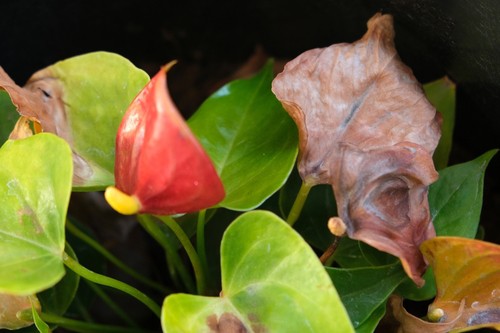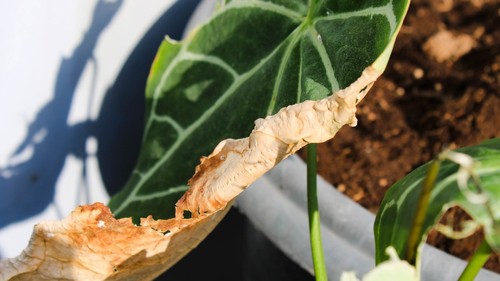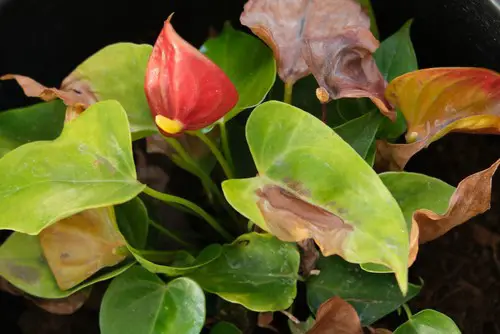Anthurium plants are known for their beautiful, glossy leaves and vibrant blooms. However, when brown spots start to appear on the leaves, it can be a cause for concern. anthurium leaves brown spots can be caused by a variety of factors, including bacterial infections, nutrient deficiencies, and excess sunlight.
It is important to identify the cause of the brown spots to ensure the plant remains healthy and continues to thrive.
Bacterial infections are a common cause of brown spots on anthurium leaves. These infections, also known as leaf blight, can be caused by various types of bacteria that infect the leaves. Nutrient deficiencies, such as a lack of magnesium or iron, can also cause brown spots on the leaves.
Additionally, excess sunlight can cause the leaves to scorch, resulting in brown spots. By understanding the causes of brown spots on anthurium leaves, plant owners can take the necessary steps to prevent and treat the issue.
Key Takeaways
- Brown spots on anthurium leaves can be caused by bacterial infections, nutrient deficiencies, and excess sunlight.
- Symptoms of brown spots include yellow lesions that darken into brown spots, bronzed-colored leaves, and spotted or faded flowers.
- Prevention and treatment methods include adjusting watering practices, providing proper lighting, fertilizing correctly, and creating an ideal environment.
Don’t miss these other related picks:
Anthurium Leaves Brown Spots – 5 Common Problems

Anthuriums are tropical plants that can be grown indoors or outdoors. However, they are susceptible to various issues, including brown spots on their leaves. These spots are a common problem that can be caused by several factors, including sunlight exposure, watering issues, soil and nutrient factors, pest and disease problems, age, and growth factors.
1. Sunlight Exposure
Excess direct sunlight is a major cause of brown leaves, leading to wilting and death of plants if left untreated. Meanwhile, too little sunlight can impede plant growth, limit photosynthesis, and reduce sprouting.
Exposing anthurium to the scorching sun gives undesirable results, with the upper leaves becoming the most affected. Thus, it is essential to provide the right amount of sunlight, preferably bright, indirect light. West-facing windows are ideal for anthuriums, but they should be positioned away from direct sunlight.
2. Watering Issues
Overwatering and underwatering are common culprits of brown spots on anthurium leaves. Overwatering can lead to root rot, which can cause the vascular system to break down and eventually kill the plant.
Underwatering can cause the leaves to wilt and turn brown, as well as the appearance of guttation droplets. It is best to water anthuriums when the soil is dry to the touch, but not completely dry. The potting mix should also be well-draining to prevent water from accumulating on the soil surface.
3. Soil and Nutrient Factors
Anthuriums require well-draining, nutrient-rich potting soil that is slightly acidic, with a pH range of 5.5 to 6.5. Nutrient deficiencies, such as nitrogen, phosphorus, and potassium, can cause brown spots on the leaves.
Over-fertilizing can also cause the accumulation of excess salts in the soil, leading to nutrient deficiencies. Thus, it is essential to feed anthuriums with a balanced fertilizer, following the recommended dosage.
4. Pest and Disease Problems
Brown spots on anthurium leaves can be caused by bacterial diseases, such as leaf blight and bacterial wilt, which are caused by Xanthomonas bacteria. Foliar nematodes, mites, aphids, mealybugs, and thrips can also cause brown spots on the leaves.
Thus, it is essential to implement a regular care routine that includes sterilizing tools and surfaces, providing adequate air circulation, and treating pests and diseases promptly.
5. Age and Growth Factors
As anthurium plants age, their leaves naturally darken and turn brown. Additionally, brown leaf tips can indicate that the plant is not getting enough water or humidity. It is also essential to repot anthuriums every two to three years to ensure that they have enough room to grow.
Symptoms of Brown Spots on Anthurium Leaves

Anthurium leaves are known for their glossy green appearance, but brown spots can appear on them, indicating an underlying issue. These spots can be an indication of a range of problems, including bacterial leaf blight, excess fertilizer, bacterial wilt, mites, foliar nematodes, nutrient deficiencies, and too much sunlight.
Bacterial leaf blight, for example, can cause yellow lesions that darken into necrotic brown spots, guttation droplets forming on the leaf margins, leaves with a bronze appearance, and faded and spotted flowers. This infection can be systemic, meaning it can spread throughout the entire plant.
Excess fertilizer can also cause brown spots on anthurium leaves. Over-fertilization can lead to a buildup of salts in the soil, which can cause leaf tips to turn brown and curl.
Bacterial wilt is another common cause of brown spots on anthurium leaves. This disease is caused by a bacterium that attacks the plant’s vascular system, causing the leaves to wilt and turn brown.
Mites and foliar nematodes can also cause brown spots on anthurium leaves. These pests feed on the plant’s tissues, causing damage that can result in brown spots.
Finally, too much sunlight can also cause brown spots on anthurium leaves. These plants thrive best in the shade, and excess direct sunlight can cause the leaves to wilt and turn brown.
Prevention and Treatment of Brown Spots
Anthurium leaves with brown spots can be a sign of bacterial diseases, fungal infections, or pest infestations. To prevent and treat brown spots on Anthurium leaves, it is essential to establish a proper care routine, manage pests and diseases, and adjust the plant’s environment.
Proper Care Routine
Anthurium plants require a consistent care routine to thrive. Proper watering, feeding, and sunlight exposure are essential to prevent brown spots on the leaves. Anthuriums prefer bright, indirect light and require well-draining soil.
Overwatering can lead to root rot, which can cause wilting and brown leaf tips. Therefore, it is crucial to water the plant only when the top inch of soil is dry and to avoid letting the plant sit in standing water.
Pruning is also an essential part of the care routine. Remove any dead or yellowing leaves with clean, sterilized scissors to prevent the spread of disease. Sterilizing the scissors with alcohol before and after pruning can help prevent bacterial wilt and other bacterial diseases.
Pest and Disease Management

Anthurium plants are susceptible to various pest infestations, including spider mites, aphids, mealybugs, thrips, and scale insects. These pests can cause foliar infections, which can lead to brown spots on the leaves. To manage pest infestations, regularly inspect the plant for signs of infestation and treat with an appropriate insecticide.
Bacterial diseases, such as bacterial blight and foliar nematodes, can also cause brown spots on Anthurium leaves. Copper fungicides can be used to treat bacterial diseases, but care must be taken to avoid phytotoxicity, which can cause further damage to the plant.
Environmental Adjustments
Anthurium plants require high humidity and indirect sunlight to thrive. Low humidity and direct sunlight can cause brown spots on the leaves. To adjust the plant’s environment, place the plant in a bright, indirect light location with good air circulation. Use a humidifier or pebble tray to increase humidity levels around the plant.
In conclusion, preventing and treating brown spots on Anthurium leaves requires a proper care routine, pest and disease management, and environmental adjustments. By following these guidelines, Anthurium plants can remain healthy and vibrant.
Frequently Asked Questions
How do I treat brown spots on my Anthurium leaves?
Treatment for brown spots on Anthurium leaves depends on the underlying cause. If the spots are caused by bacterial or fungal infections, it is recommended to remove the affected leaves and treat the plant with a fungicide or bactericide.
If the spots are caused by insect infestation, it is recommended to remove the insects and treat the plant with an insecticide. If the spots are caused by environmental factors, such as overwatering or too much direct sunlight, it is recommended to adjust the plant’s care routine accordingly.
What causes brown spots to appear on Anthurium leaves?
Brown spots on Anthurium leaves can be caused by a variety of factors, including bacterial or fungal infections, insect infestation, environmental factors such as overwatering or too much direct sunlight, nutrient deficiencies, or physical damage to the plant.
What are the common problems with Anthurium leaves?
Common problems with Anthurium leaves include brown spots, yellowing leaves, wilting, curling, and drooping. These issues can be caused by a variety of factors, including environmental factors, nutrient deficiencies, insect infestation, and disease.
How can I prevent brown spots from appearing on my Anthurium leaves?
To prevent brown spots from appearing on Anthurium leaves, it is important to provide the plant with proper care. This includes providing the plant with the right amount of water and light, avoiding over-fertilization, keeping the plant free from insect infestations, and avoiding physical damage to the plant.
What are the signs of Anthurium leaf fungal infections?
Signs of Anthurium leaf fungal infections include brown spots on the leaves, yellowing leaves, wilting, and curling. In severe cases, the plant may also develop black spots or patches on the leaves.
What is the best way to care for Anthurium leaves to avoid brown spots?
To care for Anthurium leaves and avoid brown spots, it is important to provide the plant with the right amount of water and light. The plant should be watered when the top inch of soil is dry, and should be kept in a location with bright, indirect light.
Additionally, the plant should be fertilized with a balanced fertilizer every two to four weeks, and should be kept free from insect infestations.

Hey, I’m Lisa and I’ve been an avid gardener for over 30 years. I love writing, talking and living in the garden! Feel free to connect with me on my socials below


